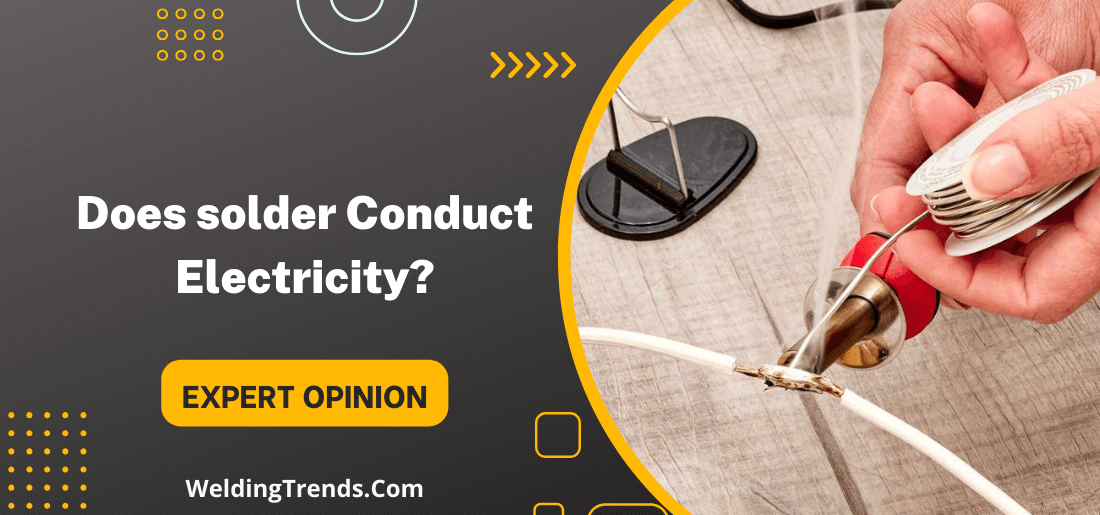It is a question that has been puzzling people for years – does solder conduct electricity? The answer, it turns out, is a bit complicated. Solder is an alloy, which means it is made up of two or more metals. The most common metals used in solder are lead and tin.
In this blog post, we will explore the science behind solder and its ability to conduct electricity. We will also look at some of the applications of solder in electronic circuits. Stay tuned!
What is solder and How does solder work?
Solder is a metal alloy that is used to create a permanent connection between two pieces of metal. The main element in solder is usually tin, but it can also contain lead, copper, antimony, and other metals.
When heated, the metals in the solder liquefy and flow into the spaces between the two pieces of metal that are being joined. As the solder cools, it hardens and creates a strong bond between the two pieces of metal.
Solder is an excellent conductor of electricity, which is why it is often used in electrical circuits. When two pieces of metal are joined together with solder, the electrons can flow freely between them, allowing current to flow through the circuit.
There are different types of solder, each with its own melting point and composition. The type of solder that is used depends on the application.
For example, lead-based solder is often used in electronics because it has a low melting point and can be easily controlled with a soldering iron. However, lead-based solder is not as strong as other types of solder and can be toxic if inhaled.
Does solder conduct electricity?
The answer to this question is a bit complicated. While solder is an excellent conductor of electricity, it is not a perfect conductor. This is because the metals that are used in solder have different electrical properties. When the metals are melted together, these properties are not always perfectly combined.
As a result, there can be areas in the solder where the electrons do not flow as freely. This can create resistance, which can cause problems in an electrical circuit. To avoid this problem, engineers often use a technique called surface mount technology.
In this process, the solder is applied to the surface of the metal, rather than being melted and flowing into the spaces between the two pieces of metal.This ensures that the solder will have a more uniform composition and will be less likely to create resistance in the circuit.
So, does solder conduct electricity? The answer is yes, but there can be some exceptions depending on the type of solder that is used and how it is applied.
Advantages of Soldering:
- Low Thermal Impact on Components: Soldering operates at lower temperatures compared to other metal-joining techniques, which helps prevent thermal damage to electronic components.
- Precision and Control: It allows for precise placement of components, making it ideal for delicate electronic circuits.
- Cost-Effectiveness: Soldering materials and equipment are relatively inexpensive, making it a cost-effective method for joining small parts.
- Excellent Electrical Connection: Provides a strong electrical bond between components, ensuring efficient signal transmission.
Disadvantages of Soldering:
- Limited Mechanical Strength: Solder joints, although solid for electrical connections, may not provide sufficient mechanical strength for all applications.
- Heat Sensitive Components: Not suitable for heat-sensitive components which may be damaged by the soldering process temperatures.
- Skill Level: Requires a certain level of skill and experience to execute properly, especially for intricate electronic assemblies.
- Potential for Toxic Exposure: The fumes produced during soldering can be hazardous if inhaled, necessitating proper ventilation or protective equipment.
Applications of soldering:
- Electronic Manufacturing: Soldering is commonly used in the manufacturing of electronic devices, such as computers, cell phones, and other consumer electronics.
- Jewelry Making: It is also a popular method for creating jewelry, as it allows for precise joining of small metal pieces.
- Plumbing: Soldering is used in plumbing to join pipes and fittings, as it creates a strong, leak-proof connection.
- Automotive Repairs: In the automotive industry, soldering is used to repair electronic components, such as wiring harnesses and circuit boards.
- Art and Decor: Soldering is not just for practical purposes but also serves an artistic function. Artists use soldering techniques to create intricate metal sculptures and decorative items.
- DIY Projects: For enthusiasts and hobbyists, soldering is a key skill for building and repairing electronics at home, from simple gadgets to complex custom projects.
- Renewable Energy Systems: Soldering plays a crucial role in the assembly and maintenance of renewable energy systems, including solar panels and wind turbines, ensuring efficient energy flow.
- Medical Equipment: Many medical devices, such as pacemakers and diagnostic equipment, require soldering for precise connections and reliable functionality.
- Military Applications: Soldering is used extensively in the military for building and repairing electronic systems and components for various weapons, vehicles, and communication devices.
- Research and Development: In research labs, soldering is used for prototyping and testing new electronic devices, allowing for quick modifications and repairs.
- Toys and Games: The production of toys and games often involves soldering for the assembly of electronic components, adding interactive features to products.
- Industrial Manufacturing: Many industries, such as aerospace, automotive, and electronics, rely on soldering for mass production of their products due to its efficiency and reliability.
These are just a few examples of the many applications of soldering in various fields. As technology continues to advance and new materials emerge, the use of soldering is likely to expand to even more industries and applications. Learning soldering techniques can open up many opportunities for individuals in different fields, making it a valuable skill to acquire.
Also Read: What Can I Use Instead Of Solder?
Problems Caused by the Conductivity of Solder:
The main problem caused by the conductivity of solder is resistance. This can occur when the solder is not applied correctly, or when the metals used in the solder have different electrical properties. When this happens, it can cause problems in an electrical circuit. To avoid this problem, engineers often use a technique called surface mount technology.
In this process, the solder is applied to the surface of the metal, rather than being melted and flowing into the spaces between the two pieces of metal. This ensures that the solder will have a more uniform composition and will be less likely to create resistance in the circuit.
Another problem that can be caused by the conductivity of solder is EMF. EMF stands for electromagnetic field, and it is a type of radiation that can be emitted by electrical circuits.
This radiation can cause interference in other nearby electronic devices. To avoid this problem, engineers often use shielded cables or enclosures around electronic circuits. Shielded cables have a metal layer that helps to deflect the EMF radiation away from the circuit. Enclosures are also used to protect circuits from EMF radiation.
FAQs:
Do all metals conduct electricity?
No, not all metals conduct electricity. Non-metals like carbon and sulfur are good conductors of electricity. Metals like gold and silver are poor conductors of electricity.
This is because the electrons in these metals are tightly bound to the nucleus and cannot move easily. However, some metals like copper and aluminum have loosely bound electrons and are good conductors of electricity.
Is solder as conductive as copper?
This is a difficult question to answer definitively because it depends on a number of factors, including the type of solder being used and the purity of the metals involved. In general, however, solder is not as conductive as copper. This is due in part to the fact that solder contains other metals (such as lead or tin) that are not as conductive as copper. Additionally, the soldering process itself can introduce impurities into the metals that can further reduce conductivity.
What is the best conductor of electricity?
The best conductor of electricity is a material that allows electrons to flow freely through it. This can be a metal like copper or silver, or it can be a non-metal like graphite. The best conductor of electricity is also a material that has a low resistance, meaning that it does not resist the flow of electrons. The best conductor of electricity is also a material that has high electrical conductivity, meaning that it can easily carry an electric current.
Does a solder act as a conductor?
Yes, solder is a conductor. It is made of metals that easily conduct electricity, such as lead and tin. When heated, the solder melts and becomes liquid, which allows it to flow easily and form bonds with other materials.
A soldier is often used to join electrical components together because it creates a strong connection that can carry electrical current.
What is solder made of?
Solder is a metal alloy that is used to create a permanent connection between two pieces of metal. The most common type of solder is made of lead and tin, but there are also lead-free and flux-cored solder options available. Solder typically has a melting point between 180 and 190 degrees Celsius.
Is soldering wire toxic?
The short answer is yes, soldering wire can be toxic if inhaled or ingested. However, the fumes produced by solder are not typically harmful unless you are exposed to them for an extended period of time. If you are concerned about the health effects of soldering, it is best to work in a well-ventilated area and avoid inhaling the fumes.
In addition, it is important to wash your hands after working with solder to avoid coming into contact with the lead and other metals that can be found in soldering wire.
What are the 4 types of solder?
The four types of solder are:
- Lead-based solder: Lead-based solder is the most common type of solder. It is made of a lead and tin alloy and is used for soldering metals such as copper, brass, and iron.
- Tin-based solder: Tin-based solder is made of tin and leads alloy. It has a lower melting point than lead-based solder and is used for soldering metals such as aluminum and stainless steel.
- Silver-based solder: Silver-based solder is made of a silver and copper alloy. It has a higher melting point than tin-based solder and is used for soldering metals such as gold and platinum.
- Aluminum-based solder: Aluminum-based solder is made of aluminum and copper alloy. It has the highest melting point of all the soldiers and is used for soldering metals such as tungsten and titanium.
Each type of solder has its own unique properties and uses.
Final Words:
After exploring the question “does solder conduct electricity?” In depth, we can confidently say that yes, solders do conduct electricity. It is a vital component in creating and repairing electronic circuits and plays a crucial role in ensuring proper electrical connectivity. By melting the solder and applying it to the conductive components, it creates a strong bond that allows for efficient flow of electrical current.
To conclude, whether you are a hobbyist tinkering with electronics or an engineer working on complex circuitry designs, understanding how solder conducts electricity is crucial knowledge. With proper use and application of this seemingly simple material, we can continue to create innovative technologies that shape our world. Thank you for joining me on this exploration of solder’s conduction abilities. Let’s continue to learn new things and push boundaries together!




